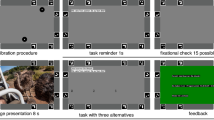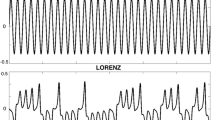Abstract
In this study, we explored whether gaze and posture would exhibit coordination with the motion of a presented visual stimulus, specifically with regard to the complexity of the motion structure. Fourteen healthy adults viewed a set of four visual stimulus motion conditions, in both self-selected and semi-tandem stance, during which the stimulus moved horizontally across a screen, with position updated to follow a sine, chaos, surrogate, or random noise trajectory. Posture was measured using a standard force platform in self-selected and semi-tandem stance conditions while gaze was recorded using image-based eye-tracking equipment. Cross-correlation confirmed the continuous coordination of gaze with each type of stimulus motion, with increasing lag as stimulus motion complexity increased. Correlation dimension and approximate entropy were used to assess the complexity of the measured gaze and posture behaviors, with these values compared against those of the actual stimulus via ANOVA and dependent t tests. We found that gaze behavior was particularly sensitive to the complexity of the stimulus motion, according to both metrics. Posture seemed to be unaffected by stimulus motion viewing; however, different stance conditions did exhibit differences in posture metrics. Our results support an evolving understanding of how vision is used for determining perception and action.





Similar content being viewed by others
References
Abarbanel HDI (1996) Analysis of observed chaotic data. Springer, New York
Amblard B, Carblanc A (1980) Role of foveal and peripheral visual information in maintenance of postural equilibrium in man. Percept Motor Skills 51:903–912
Bernstein N (1967) The co-ordination and regulation of movement. Pergamon Press, New York
Boccignone F (2004) Modelling gaze shift as a constrained random walk. Phys A 331:207
Born RT, Pack CC, Zhao R (2002) Integration of motion cues for the initiation of smooth pursuit eye movements. In: Hyönä J, Munoz DP, Heide W, Radach R (eds) Prog Brain Res, vol. 140. Elsevier Science
Dokka K, Kenyon RV, Keshner EA, Kording KP (2010) Self versus environment motion in postural control. PLoS Comput Biol 6:e1000680
Gibson J (1966) The senses considered as perceptual systems. Houghton Mifflin Co, Boston
Gibson J (1979) The ecological approach to visual perception. Houghton Mifflin Co, Boston
Giveans MR, Yoshida K, Bardy B, Riley M, Stoffregen TA (2011) Postural sway and the amplitude of horizontal eye movements. Ecol psychol 23:247–266
Glasauer S, Schneider E, Jahn K, Strupp M, Brandt T (2005) How the eyes move the body. Neurology 65:1291–1293
Goodale MA, Milner AD (1992) Separate visual pathways for perception and action. Trends Neurosci 15:20–25
Grassberger P, Procaccia I (1983) Characterization of strange attractors. Phys Rev Lett 50:346–349
Guerraza M, Bronsteinb AM (2008) Ocular versus extraocular control of posture and equilibrium. Clin Neurophysiol 38:391–398
Haworth J, Vallabhajosula S, Tzetzis G, Stergiou N (2013) Optimal variability and complexity: a novel approach for management principles. In: Banerjee S (ed) Chaos and complexity theory for management: nonlinear dynamics. IGI Global, USA
Jeka JJ, Oie K, Schöner G, Dijkstra T, Henson E (1998) Position and velocity coupling of postural sway to somatosensory drive. J Neurophysiol 79:1661–1674
Jeka J, Allison L, Saffer M, Zhang Y, Carver S, Kiemel T (2006) Sensory reweighting with translational visual stimuli in young and elderly adults: the role of state-dependent noise. Exp Brain Res 174:517–527
Kay BA, Warren WH (2001) Coupling of posture and gait: mode locking and parametric excitation. Biol Cybern 85:89–106
Kelso JAS (1995) Dynamic patterns: the self-organization of brain and behavior. MIT Press, Cambridge
Kirby RL, Price NA, MacLeod DA (1987) The influence of foot position on standing balance. J Biomech 20(4):423–427
Kowler E (2011) Eye movements: the past 25 years. Vision Res 51:1457–1483
Laurens J, Awai L, Bockisch CJ, Hegemann S, van Hedel HJA, Dietz V, Straumann D (2010) Visual contribution to postural stability: interaction between target fixation or tracking and static or dynamic large-field stimulus. Gait Posture 31:37–41
Milner AD, Goodale MA (2008) Two visual systems re-viewed. Neuropsychologia 46:774–785
Nejc S, Jernej R, Loefler S, Kern H (2010) Sensitivity of body sway parameters during quiet standing to manipulation of support surface size. J Sports Sci Med 9:431–438
Newell KM, Challis S, Morrison S (2000) Dimensional constraints on limb movements. Hum Mov Sci 19:175–201
O’Connor SM, Kuo AD (2009) Direction-dependent control of balance during walking and standing. J Neurophysiol 102:1411–1419
Pincus (1991) Approximate entropy as a measure of system complexity. P Natl Acad Sci USA 88:2297–2301
Piponnier JC, Hanssens JM, Faubert J (2009) Effect of visual field locus and oscillation frequencies on posture control in an ecological environment. J Vision 9:13
Ravaioli E, Oie KS, Kiemel T, Chiari L, Jeka JJ (2005) Nonlinear postural control in response to visual translation. Exp Brain Res 160:450–459
Renaud P, Décarie J, Gourd SP, Paquin LC, Bouchard S (2003) Eye-Tracking in immersive environments: a general methodology to analyze affordance-based interactions from oculomotor dynamics. Cyberpsychol Behav 6:519
Renaud P, Chartier S, Albert G, Décarie J, Cournoyer LG, Bouchard S (2007) Presence as determined by fractal perceptual-motor dynamics. Cyberpsychol Behav 10:122
Renninger LW, Verghese P, Coughlan J (2007) Where to look next? Eye movements reduce local uncertainty. J Vision 7:6
Richardson D, Dale R, Shockley K (2008) Synchrony and swing in conversation: coordination, temporal dynamics and communication. In: Wachsmuth I, Lenzen M, Knoblich G (eds) Embodied communication. Oxford University Press, Oxford, pp 75–93
Stergiou N, Buzzi UH, Kurz MJ, Heidel J (2004) Nonlinear tools in human movement. In: Stergiou N (ed) Innovative analyses of human movement. Human Kinetics, Champaign, pp 63–90
Stergiou N, Harbourne RT, Cavanaugh JT (2006) Optimal movement variability: a new theoretical perspective for neurologic physical therapy. J Neurol Phys Ther 30:120–129
Stoffregen TA, Pagulayan RJ, Bardy BG, Hettinger LJ (2000) Modulating postural control to facilitate visual performance. Hum Mov Sci 19:203–220
Stoffregen TA, Hove P, Schmit J, Bardy BG (2006) Voluntary and involuntary postural responses to imposed optic flow. Mot Control 10:24–33
Stoffregen TA, Bardy BG, Bonnet CT, Hove P, Oullier O (2007) Postural sway and the frequency of horizontal eye movements. Mot Control 11:86–102
Thaler L, Goodale MA (2010) Beyond distance and direction: the brain represents target locations non-metrically. J Vision 10(3):1–27
Thaler L, Todd JT (2010) Evidence from visuomotor adaptation for two partially independent visuomotor systems. J Exp Psychol Hum Percept Perform 36(4):924–935
Theiler J, Eubank S, Longtin A, Galdrikian B, Farmer JD (1992) Testing for nonlinearity in time series: the method of surrogate data. Physica D 58:77–94
Thelen E, Smith LB (1996) A dynamic systems approach to the development of cognition and action. MIT Press/Bradford Books Series in Cognitive Psychology, Cambridge
Vaillancourt N (2000) The dynamics of resting and postural tremor in Parkinson’s disease. Clin Neurophysiol 111:2045–2056
Wade MG, Jones G (1997) The role of vision and spatial orientation in the maintenance of posture. Phys Ther 77:619–628
Wang Z, Newell KM (2012) Phase synchronization of foot dynamics in quiet standing. Neurosci Lett 507:47–51
Zentgraf K, Munzert J, Bischoff M, Newman-Norlund RD (2011) Simulation during observation of human actions: theories, empirical studies, applications. Vision Res 51:827–835
Acknowledgments
This work was supported by National Institutes of Health (Grant Number K25HD047194), National Institute of Disability and Rehabilitation Research (Grant Numbers H133G040118, H133G080023), the Nebraska Research Initiative, NASA Nebraska Space Grant Fellowship, and a Dennis Weatherstone Pre-doctoral Fellowship from Autism Speaks (Grant Number 7070).
Conflict of interest
There is no conflict of interest associated with this research.
Author information
Authors and Affiliations
Corresponding author
Rights and permissions
About this article
Cite this article
Haworth, J.L., Vallabhajosula, S. & Stergiou, N. Gaze and posture coordinate differently with the complexity of visual stimulus motion. Exp Brain Res 232, 2797–2806 (2014). https://doi.org/10.1007/s00221-014-3962-5
Received:
Accepted:
Published:
Issue Date:
DOI: https://doi.org/10.1007/s00221-014-3962-5




